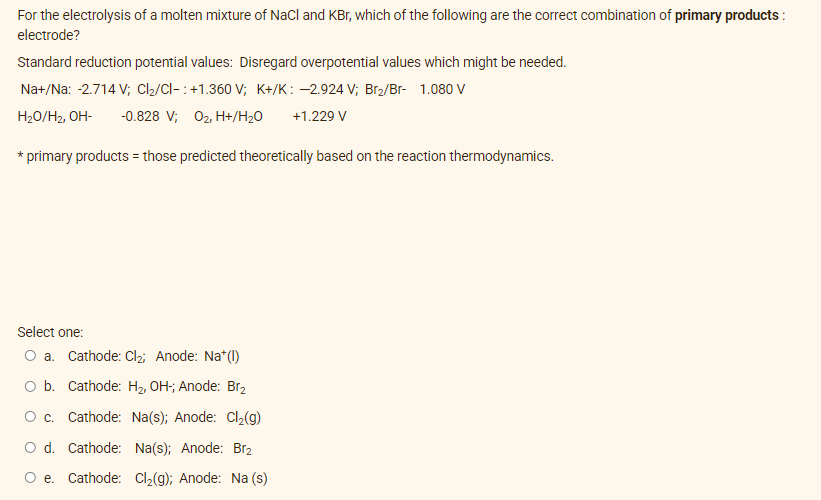For the electrolysis of a molten mixture of NaCl and KBr, which of the following are the correct combination of primary products: electrode? Standard reduction potential values: Disregard overpotential values which might be needed. Na+/Na: -2.714 V; Cl₂/Cl-: +1.360 V; K+/K: -2.924 V; Br₂/Br- 1.080 V H₂O/H₂, OH- -0.828 V; 0₂, H+/H₂O +1.229 V * primary products = those predicted theoretically based on the reaction thermodynamics. Select one: O a. Cathode: Cl₂; Anode: Na+ (1) O b. Cathode: H₂, OH-; Anode: Br₂ O c. Cathode: Na(s); Anode: Cl₂(g) O d. Cathode: Na(s); Anode: Br₂ O e. Cathode: Cl₂(g); Anode: Na (s)
For the electrolysis of a molten mixture of NaCl and KBr, which of the following are the correct combination of primary products: electrode? Standard reduction potential values: Disregard overpotential values which might be needed. Na+/Na: -2.714 V; Cl₂/Cl-: +1.360 V; K+/K: -2.924 V; Br₂/Br- 1.080 V H₂O/H₂, OH- -0.828 V; 0₂, H+/H₂O +1.229 V * primary products = those predicted theoretically based on the reaction thermodynamics. Select one: O a. Cathode: Cl₂; Anode: Na+ (1) O b. Cathode: H₂, OH-; Anode: Br₂ O c. Cathode: Na(s); Anode: Cl₂(g) O d. Cathode: Na(s); Anode: Br₂ O e. Cathode: Cl₂(g); Anode: Na (s)
Principles of Modern Chemistry
8th Edition
ISBN:9781305079113
Author:David W. Oxtoby, H. Pat Gillis, Laurie J. Butler
Publisher:David W. Oxtoby, H. Pat Gillis, Laurie J. Butler
Chapter17: Electrochemistry
Section: Chapter Questions
Problem 59P
Related questions
Question

Transcribed Image Text:For the electrolysis of a molten mixture of NaCl and KBr, which of the following are the correct combination of primary products:
electrode?
Standard reduction potential values: Disregard overpotential values which might be needed.
Na+/Na: -2.714 V; Cl₂/Cl-: +1.360 V; K+/K: -2.924 V; Br₂/Br- 1.080 V
H₂O/H₂, OH- -0.828 V; 0₂, H+/H₂O +1.229 V
* primary products = those predicted theoretically based on the reaction thermodynamics.
Select one:
O a. Cathode: Cl₂; Anode: Na+ (1)
O b. Cathode: H₂, OH-; Anode: Br₂
O c. Cathode: Na(s); Anode: Cl₂(g)
O d. Cathode:
Na(s); Anode: Br₂
O e. Cathode: Cl₂(g); Anode: Na (s)
Expert Solution
This question has been solved!
Explore an expertly crafted, step-by-step solution for a thorough understanding of key concepts.
Step by step
Solved in 2 steps with 1 images

Knowledge Booster
Learn more about
Need a deep-dive on the concept behind this application? Look no further. Learn more about this topic, chemistry and related others by exploring similar questions and additional content below.Recommended textbooks for you

Principles of Modern Chemistry
Chemistry
ISBN:
9781305079113
Author:
David W. Oxtoby, H. Pat Gillis, Laurie J. Butler
Publisher:
Cengage Learning

Chemical Principles in the Laboratory
Chemistry
ISBN:
9781305264434
Author:
Emil Slowinski, Wayne C. Wolsey, Robert Rossi
Publisher:
Brooks Cole


Principles of Modern Chemistry
Chemistry
ISBN:
9781305079113
Author:
David W. Oxtoby, H. Pat Gillis, Laurie J. Butler
Publisher:
Cengage Learning

Chemical Principles in the Laboratory
Chemistry
ISBN:
9781305264434
Author:
Emil Slowinski, Wayne C. Wolsey, Robert Rossi
Publisher:
Brooks Cole


Chemistry: An Atoms First Approach
Chemistry
ISBN:
9781305079243
Author:
Steven S. Zumdahl, Susan A. Zumdahl
Publisher:
Cengage Learning


Chemistry
Chemistry
ISBN:
9781305957404
Author:
Steven S. Zumdahl, Susan A. Zumdahl, Donald J. DeCoste
Publisher:
Cengage Learning